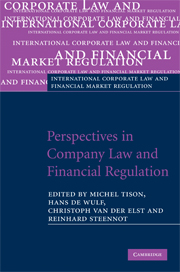Book contents
- Frontmatter
- Contents
- List of contributors
- Foreword
- PART I Perspectives in company law, SECTION 1: European company law: regulatory competition and free movement of companies
- PART 1 Perspectives in company law, SECTION 2: Corporate governance, shareholders' rights and auditing
- PART 1 Perspectives in company law, SECTION 3: Takeover law
- PART II Perspectives in financial regulation, SECTION 1: European perspectives
- PART 2 Perspectives in financial regulation, SECTION 2: Transatlantic perspectives
- 28 Learning from Eddy: a meditation upon organizational reform of financial supervision in Europe
- 29 The SEC embraces mutual recognition
- 30 Steps toward the Europeanization of US securities regulation, with thoughts on the evolution and design of a multinational securities regulator
- 31 The subprime crisis – does it ask for more regulation?
- 32 Juries and the political economy of legal origin
- PART III Miscellaneous
- Index
- References
30 - Steps toward the Europeanization of US securities regulation, with thoughts on the evolution and design of a multinational securities regulator
from PART 2 - Perspectives in financial regulation, SECTION 2: Transatlantic perspectives
Published online by Cambridge University Press: 04 August 2010
- Frontmatter
- Contents
- List of contributors
- Foreword
- PART I Perspectives in company law, SECTION 1: European company law: regulatory competition and free movement of companies
- PART 1 Perspectives in company law, SECTION 2: Corporate governance, shareholders' rights and auditing
- PART 1 Perspectives in company law, SECTION 3: Takeover law
- PART II Perspectives in financial regulation, SECTION 1: European perspectives
- PART 2 Perspectives in financial regulation, SECTION 2: Transatlantic perspectives
- 28 Learning from Eddy: a meditation upon organizational reform of financial supervision in Europe
- 29 The SEC embraces mutual recognition
- 30 Steps toward the Europeanization of US securities regulation, with thoughts on the evolution and design of a multinational securities regulator
- 31 The subprime crisis – does it ask for more regulation?
- 32 Juries and the political economy of legal origin
- PART III Miscellaneous
- Index
- References
Summary
Introduction
The United States currently faces a set of regulatory issues that are profoundly important to the future of its form of securities regulation and hence its place in the global capital marketplace. Calls for extensive reform have come from a well-publicized set of studies that question the ability of the US to be competitive worldwide because of excessive regulation and an overdeveloped litigation culture.
One of the principal moves being considered takes the form of mutual recognition. The likely first stage of this would be the invitation to foreign stock exchanges and securities firms to have a presence in the US without registration with the SEC as a domestic exchange or broker-dealer firm, upon the determination that adequate home country regulation exists and can be relied upon as a substitute for direct SEC oversight. As part of this, however, would be some attention to a bigger project: the potential for mutual recognition of issuer disclosure and governance rules. Foreign trading screens and foreign broker-dealer presence in the US is meaningful largely as a means of making foreign securities more readily available to US investors, and the potential for increased competition and lower costs will hardly follow if making such securities available means intense US regulation of the issuers of those securities. Some mutual recognition of issuer disclosure standards is thus inevitable if the project is to succeed, and the SEC has already taken steps in this direction with the recent determination that foreign issuers do not have to reconcile their financial reporting to US generally accepted accounting principles.
- Type
- Chapter
- Information
- Perspectives in Company Law and Financial Regulation , pp. 555 - 569Publisher: Cambridge University PressPrint publication year: 2009

